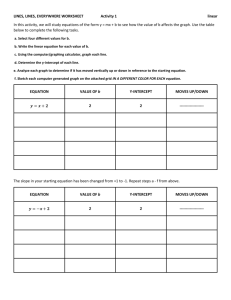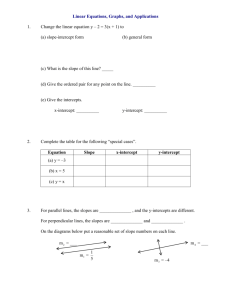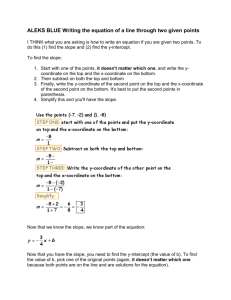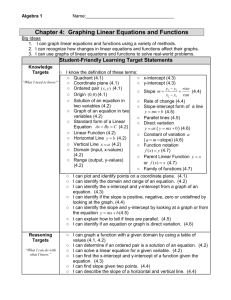Chapter 5 Graphing Linear Equations and Inequalities 5.1 The
advertisement
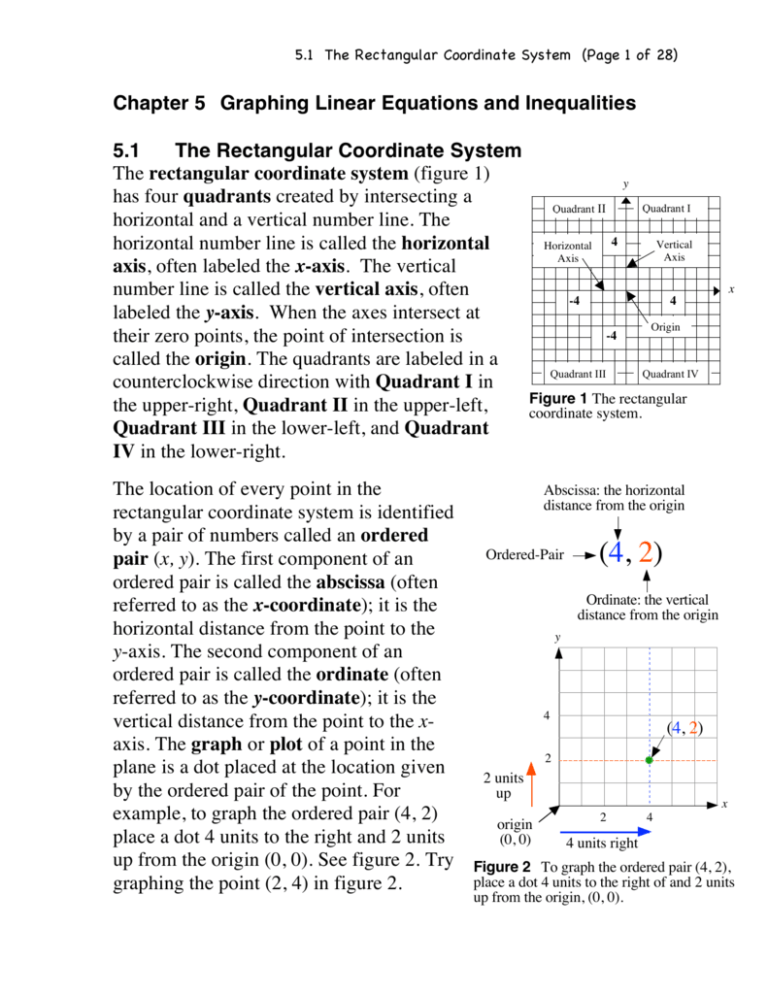
5.1 The Rectangular Coordinate System (Page 1 of 28) Chapter 5 Graphing Linear Equations and Inequalities 5.1 The Rectangular Coordinate System The rectangular coordinate system (figure 1) has four quadrants created by intersecting a horizontal and a vertical number line. The horizontal number line is called the horizontal axis, often labeled the x-axis. The vertical number line is called the vertical axis, often labeled the y-axis. When the axes intersect at their zero points, the point of intersection is called the origin. The quadrants are labeled in a counterclockwise direction with Quadrant I in the upper-right, Quadrant II in the upper-left, Quadrant III in the lower-left, and Quadrant IV in the lower-right. The location of every point in the rectangular coordinate system is identified by a pair of numbers called an ordered pair (x, y). The first component of an ordered pair is called the abscissa (often referred to as the x-coordinate); it is the horizontal distance from the point to the y-axis. The second component of an ordered pair is called the ordinate (often referred to as the y-coordinate); it is the vertical distance from the point to the xaxis. The graph or plot of a point in the plane is a dot placed at the location given by the ordered pair of the point. For example, to graph the ordered pair (4, 2) place a dot 4 units to the right and 2 units up from the origin (0, 0). See figure 2. Try graphing the point (2, 4) in figure 2. y Quadrant II Quadrant I 4 Horizontal Axis Vertical Axis -4 x 4 -4 Quadrant III Origin Quadrant IV Figure 1 The rectangular coordinate system. Abscissa: the horizontal distance from the origin Ordered-Pair (4, 2) Ordinate: the vertical distance from the origin y 4 (4, 2) 2 2 units up origin (0, 0) x 2 4 4 units right Figure 2 To graph the ordered pair (4, 2), place a dot 4 units to the right of and 2 units up from the origin, (0, 0). 5.1 The Rectangular Coordinate System (Page 2 of 28) Example 1 Graph the following ordered pairs. Label each point and identify the quadrant each y point lies in. 1. A(2, 5) and B(5, 2) 5 2. C(3, -6) and D(-6, 3) -5 3. 5 x E(4, 0) and F(0, 4) -5 4. G(-5, -3) and H(-3, -5) Example 2 Identify the ordered-pair location of each point on the graph. A( , ) y B( , ) A D C( , ) D( , ) E( , ) F( , ) 4 E G( , ) -4 B G -4 C x 4 F 5.1 The Rectangular Coordinate System (Page 3 of 28) 5.1.2 Scatter Diagrams A scatter diagram is the graph of known ordered-pair data. A scatter diagram illustrates the visual relationship between the two variables in the ordered pair. Example 2 A study by the Federal Aviation Administration showed that narrow, over-the-wing emergency exit rows slow passenger evacuation. The table below shows the space between seats, in inches, and the evacuation time for 35 passengers. Graph the scatter diagram for the data. x Space Between Seats (inches) y Evacuation Time (seconds) 6 10 13 15 20 44 43 38 36 37 Evacuation Time (seconds) y 45 40 35 x 30 0 5 10 15 20 25 Space Between Seats (inches) 5.1.3 Average Rate of Change Given two ordered-pairs (x1 , y1 ) and (x 2 , y2 ) the average rate of change (ARC) of y with respect to x is given by ARC = change in y second y value - first y value y2 ! y1 = = change in x second x value - first x value x 2 ! x1 Example 3 From the data in example 3, find the average rate of change (ARC) using the points (6, 44) and (20, 37). Analyze the units of the ARC to interpret your results. 5.2 Graphs of Linear Equations (Page 4 of 28) 5.2 Graphs of Linear Equations (Straight Lines) 5.2.1 Linear Equations in Two Variables in the form y = mx + b A linear equation in two variables is any equation whose graph forms a straight line. One form of a linear equation in two variables is y = mx + b , where x and y are the variables, m is the [constant] coefficient of x, and b is also a constant. A second form will be discussed in the next section. Example 1 For each equation, identify the constants m and b. Equation, y = mx + b y = 3x + 4 y = !x ! 7 y = !3 y = !5x 2 y= ! x+3 3 m 3 b 4 Solution to a Linear Equation in Two Variables A solution to a linear equation in two variables is an ordered pair of numbers (x, y) that [when substituted for the variables] makes the equation true. Example 2 Is (3, -5) a solution to y = !3x + 4 ? Example 3 " 2 % Is $ ! , ! 2 ' a solution to y = !3x + 4 ? # 3 & 5.2 Graphs of Linear Equations (Page 5 of 28) 5.2.2 Graphs of Linear Equations in the form y = mx + b Equations with two variables have an infinite number of ordered-pair solutions. The graph of an equation in two variables is a drawing of all the ordered-pair solutions to the equation. The graph of every linear equation in two variables (i.e. y = mx + b ) forms a straight line. Graphing Linear Equations by Plotting Three Points To graph a linear equation in the form y = mx + b : 1. Pick three values for x. 2. For each x chosen in step 1, use the given equation, y = mx + b , to compute the three corresponding values of y. 3. Plot the three ordered pairs and use a ruler to draw a straight line through the points. Draw the line through the entire grid and draw arrowheads at each end of the line to show that the line continues indefinitely. Example 5 y Graph y = 2x ! 3 by finding three solutions. 5 -5 5 -5 x 5.2 Graphs of Linear Equations (Page 6 of 28) y Example 6 Graph y = !3x + 2 by finding three solutions. 5 -5 5 x 5 x 5 x -5 Example 7 y 2 Graph y = x ! 4 by 3 finding three solutions. 5 -5 -5 Example 8 y 1 Graph y = ! x + 3 by 2 finding three solutions. 5 -5 -5 5.2 Graphs of Linear Equations (Page 7 of 28) 5.2.3 Graphs of Equations in the form Ax + By = C Steps to graph a linear equation in the form Ax + By = C To graph a linear equation in the form Ax + By = C : 1. Solve Ax + By = C for y. That is, isolate y to get the equation in the form y = mx + b . 2. Graph by plotting three points. i. Pick three values for x. ii. For each x chosen in step i, use the equation from step i ( y = mx + b ) to compute the three corresponding values of y. iii. Plot the three ordered pairs and use a ruler to draw a line through the points. Draw the line through the entire grid and draw arrowheads at each end of the line to show that the line continues indefinitely. Example 10 Graph 2x + 3y = 6 by finding three solutions. 1. Solve the equation for y. y 2. Compute three points and graph. 5 Pick x Compute y = Plot (x, y) x= -5 5 x= x= -5 3. Write the ordered-pair where the graph intersects the x-axis. 4. Write the ordered-pair where the graph intersects the y-axis. x 5.2 Graphs of Linear Equations (Page 8 of 28) Example 11 Graph 2x ! 5y = 10 by finding three solutions. 1. Solve the equation for y. y 2. Plot three points and graph. Pick x Compute y = 5 Plot (x, y) x= -5 5 x= -5 x= 3. The x-intercept in a graph is the ordered-pair (x, y) location where the graph intersects the x-axis. Write the x-intercept in the graph of 2x ! 5y = 10 . What is the value of the y-component of the x-intercept? 4. The y-intercept in a graph is the ordered-pair (x, y) location where the graph intersects the y-axis. Write the y-intercept in the graph of 2x ! 5y = 10 . What is the value of the x-component of the y-intercept? x 5.2 Graphs of Linear Equations (Page 9 of 28) 5.2.4 Graph lines using the x- and y-Intercepts Intercepts of a Curve (Graph) The x-intercept of a graph is the point (ordered pair location) where the graph intersects the x-axis. The y-intercept of a graph is the ordered pair location where the graph intersects the y-axis. Example 5 a. Identify the intercepts of each curve. A 4 Curve x-intercept y-intercept A B C ( ( ( , , , ) ) ) ( ( ( , , , ) ) ) y -4 4 -4 b. What is the y value of all x-intercepts? c. B C What is the x value of all y-intercepts? Finding intercepts when given an equation. 1. All x-intercepts are in the form (a, 0), where a is a constant [number]. To find the x-intercept, set y = 0 and solve for x. 2. All y-intercepts are in the form (0, a), where a is a constant. To find the y-intercept, set x = 0 and solve for y. x 5.2 Graphs of Linear Equations (Page 10 of 28) Example 12 Find the x- and y-intercepts in the graph of 5x + 4 y = 20 . Then graph the line. Solution An x-intercept is in the form (?, 0). Thus, set y = 0 and find the corresponding value of x. Set y = 0 An x-intercept is in the form (? , 0) The x-intercept (4, 0) 5x + 4y = 20 5x + 4(0) = 20 5x = 20 is x=4 Solve for x A y-intercept is in the form (0, ?). Thus, set x = 0 and find the corresponding value of y. Set x = 0 5x + 4y = 20 A y-intercept 5(0) + 4y = 20 is in the form (0 , ?) 4y = 20 The y-intercept is y=5 Solve for y (0, 5) y Thus, the x-intercept is (4, 0) and the yintercept is (0, 5). Now, graph the line using the intercepts. 5 -5 5 -5 x 5.2 Graphs of Linear Equations (Page 11 of 28) Example 13 Find the x- and y-intercepts of !3x + 7y = 21 and graph the line. y 5 -5 5 x -5 Example 15 Find the x- and y-intercepts of 3x ! 4 y = 12 and graph the line. y 5 -5 5 -5 x 5.2 Graphs of Linear Equations (Page 12 of 28) Mentally finding an x-intercept Recall, an x-intercept is in the form (___, 0). So, to find the xintercept set y = 0 and solve for the x-coordinate. Then write the intercept as an ordered-pair. Since setting y = 0 makes the term containing y disappear, you can simply cover the “y-term” and mentally solve for x. In the following illustration, the shaded-out parts indicate the computations done mentally: Conventional method of finding the x-intercept Mentally find the x-intercept !4x ! y = 8 !4x ! 0 = 8 !4x =8 !4x ! y = 8 8 x = x = !2 Since y = 0, the term containing y disappears. So, just put your finger over the y-term and mentally solve –4x = 8 to get x = -2. x = x = !2 x ! int . is (!2, 0) 8 !4 !4 Thus the x-intercept is (-2, 0). Similarly, covering the x-term will allow you to mentally find that the y-intercept is (0, -8). Example 16 Find the x- and y-intercepts in the graph of each equation. Equation x-intercept A B C Ax + By = C (a, 0) 3x + 4 y = 12 2x ! 5y = 10 x ! 2y = !6 x ! 2y = !9 !x + 3y = !2 3 4 12 (4, 0) y-intercept (0, b) (0, 3) 5.2 Graphs of Linear Equations (Page 13 of 28) Equations & Graphs of Horizontal and Vertical Lines y Horizontal Lines All horizontal lines have the equation y = b , where b is a constant. The y-intercept in the graph of y = b is (0, b). y=b (0, b) x y Vertical Lines All vertical lines have the equation x = a , where a is a constant. The xintercept in the graph of x = a is (a, 0). x=a x (a, 0) Example 18 Graph each equation. Label each graph. a. x = !5 b. y=7 c. x=3 d. y = !1 y 5 -5 e. f. What is the equation of line lying on the x-axis? What is the equation of the line lying on the y-axis? 5 -5 x 5.3: Slope of a Line (Page 14 of 28) 5.3.1 Slope of a Line The measure of a line’s slant is called the slope of the line, denoted m. The slope of a non-vertical line containing the two points P1 (x1 , y1 ) and P2 (x 2 , y2 ) is given by rise y2 ! y1 "y m= = = . run x 2 ! x1 "x y read “change in y “ read “change in x“ y P2 (x 2 , y 2 ) P2 y2 rise P1 rise = y 2 ! y1 P1 (x1, y1 ) y1 run run = x 2 ! x1 x x x2 x1 Figure 1 Slope of a line, m = rise y 2 ! y1 = run x 2 ! x1 Example 1 a. Graph the line containing the two points (!2, 4) and (8, !1) . Then compute the slope of the line. y 5 -5 b. Pick two other points on the line in part a and compute the slope of the line using those two points. 5 -5 c. A line that falls from left to right is called a decreasing line. Decreasing lines have a slope that is [positive negative]. circle one x 5.3: Slope of a Line (Page 15 of 28) Example 2 a. Graph the line containing the two points (!5, ! 5) and (7, 3) . Then compute the slope of the line. y 5 -5 b. A line that rises from left to right is called an increasing line. Increasing lines have a slope that is [positive negative]. 5 x 5 x -5 Example 3 a. Graph the line containing the two points (6, 4) and (6,1) . Then compute the slope of the line. y 5 b. Vertical lines have a slope that is [positive negative zero undefined]. -5 -5 c. List three other ordered-pairs on the line. d. What is the equation of the line? 5.3: Slope of a Line (Page 16 of 28) y Example 4 a. Graph the line containing the two points (!7, ! 5) and (1, ! 5) . Then compute the slope of the line. 5 -5 b. Horizontal lines have a slope that is [positive negative zero undefined]. 5 x -5 c. List three other ordered-pairs on the line. d. What is the equation of the line? Example 5 a. Graph the line containing the two points (6, 3) and (!2, 7) . Then compute the slope of the line. b. Graph the line containing the two points (6, !1) and (2,1) . Then compute the slope of the line. c. What can be said about the two lines from parts a and b? y 5 -5 5 -5 x 5.3: Slope of a Line (Page 17 of 28) 5.3.2 Slopes of Parallel and Perpendicular Lines Slopes of Parallel lines Two non-vertical lines are parallel if and only if their slopes are equal. The preceding statement is equivalent to the following three: 1. If two non-vertical lines are parallel, then their slopes are equal. 2. If two non-vertical lines have equal slopes, then they are parallel. 3. All vertical lines are parallel. Slopes of Perpendicular lines Two lines are perpendicular if and only if their slopes are opposite reciprocals of each other. That is, if two lines l1 and l2 have slopes m1 and m 2 , respectively, then the preceding statement is equivalent to the following three: 1 1. If l1 is perpendicular to l2 , then m1 = ! . m2 1 2. If m1 = ! , then l1 is perpendicular to l2 . m2 3. Every horizontal line is perpendicular to every vertical line. Example 6 For each slope given, fill-in the table with the slope of every line parallel to and perpendicular to a line with the given slope. Slope 2 3 !4 ! 3 8 0 undefined Slope of any parallel line Slope of any perpendicular line 5.3: Slope of a Line (Page 18 of 28) Example 7 a. Graph the line containing the two points (6, 3) and (!2, 7) . Then compute the slope of the line. y 5 -5 b. Graph the line containing the two points (!2, ! 3) and (3, 7) . Then compute the slope of the line. c. What can be said about the two lines from parts a and b? 5 -5 x 5.3: Slope of a Line (Page 19 of 28) 5.3.2 Graph a line using the slope and y-intercept Slope-Intercept Form of a Straight Line The Slope-Intercept Form of a Straight Line is given by y = mx + b , where the slope of the line is m and the y-intercept is (0, b). To find the y-intercept, set x = 0 Example 1 Identify the slope and y-intercept in the graph of each equation. Equation, y = mx + b 3 y = ! x +1 4 Slope = m y-intercept, (0, b) y = 2x ! 4 x y = +5 2 y = !x y=2 Example 2 Graph y = 2x ! 3 using the slope and y-intercept. i. Identify the slope and y-intercept. y 5 ii. Plot the y-intercept. rise , to generate run other points on the line. iii. Use the slope, m = -5 5 -5 x 5.3: Slope of a Line (Page 20 of 28) y Example 3 Use the slope and yintercept to graph 2 y = ! x +1. 3 5 -5 5 x 5 x 5 x -5 y Example 4 Use the slope and yintercept to graph 1 y = ! x ! 2. 4 5 -5 -5 y Example 5 Use the slope and yintercept to graph y = 3x + 5 . 5 -5 -5 5.4: Finding the Equation of a Line (Page 21 of 28) 5.4.1 Finding the Equation of a Straight Line Using the Slope-Intercept form of a line ( y = mx + b ) When asked to find the equation of a line using the slope-intercept form ( y = mx + b ) of the line, the goal is to find the constants m and b (x and y remain as variables). Steps to find the equation of a straight line using the slope-intercept form of a line ( y = mx + b ) 1. Substitute the given values for x, y and m into y = mx + b and solve for the value of b. 2. Keep x and y as variables and substitute the now known values for m and b into the equation y = mx + b . Example 1 Find the equation of the line that has slope 3 and passes through the point (0, 2). Set m = _____, x = _____, and y = _____ in the equation y = mx + b , and solve for b. Then write the equation in the form y = mx + b . Example 2 Find the equation of the line that has slope -1/2 and passes through the point (-2, 4). Set m = _____, x = _____, and y = _____ in the equation y = mx + b , and solve for b. Then write the equation in the form y = mx + b . 5.4: Finding the Equation of a Line (Page 22 of 28) Example 3 Find the equation of the line that has slope 2/3 and passes through the point (3, -3). Example 4 Find the equation of the line that has slope –3/2 and passes through the point (4, - 2). 5.4: Finding the Equation of a Line (Page 23 of 28) 5.4.2 Finding the Equation of a line using the Point-Slope formula, y ! y1 = m(x ! x1 ) Point-Slope Formula for a Line The point-slope formula for a line is y ! y1 = m(x ! x1 ) , where the line has slope m and passes through the point whose coordinates are (x1 , y1 ). Example 1 Use the point-slope formula to find the equation of the line that that passes through the point (!2, !1) and has slope 3/2. 5.4.3 Finding the Equation of a line given two points on the line. Example 2 Find the equation of the line that passes through the points (-4, -5) and (8, 4). 5.4: Finding the Equation of a Line (Page 24 of 28) Example 3 Find the equation of the line that passes through the points (-3, -9) and (1, -1). y Example 4 a. Find the equation of line 1. 4 -4 4 -4 b. Find the equation of line 2. Skip section 5.5 line 1 line 2 x 5.6: Graphing Linear Inequalities (Page 25 of 28) 5.6 Graphing Linear Inequalities in Two Variables Linear Inequality in two Variables A linear inequality in two variables is two expressions separated by one of the inequality symbols (<, >, !, ") . Example 1 y Graph y = x ! 2 5 -5 5 -5 Note The graph of y = x ! 2 separates the coordinate plane into three disjoint sets of points: The set of points y = x ! 2 , which lie on the line. 1. On the Line: 2. Above the Line: The set of points y > x ! 2 , which lie “above” the line. The region above the line is called the upper half-plane. 3. Below the Line: The set of points y < x ! 2 , which lie “below” the line. The region below the line is called the lower half-plane. x 5.6: Graphing Linear Inequalities (Page 26 of 28) Steps to Graph an Inequality 1. Solve the inequality for y (isolate y). 2. Graph the line y = mx + b as a solid or dashed line as follows: a. Draw a solid line if the inequality from step 1 is in the form y ! mx + b or y ! mx + b . A solid line indicates the line is part of the solution set. b. Draw a dashed line if the inequality from step 1 is in the form y > mx + b or y < mx + b . A dashed line indicates the line is just a boundary and is not part of the solution set. 3. Shade-in the upper half-plane or the lower half-plane as follows: a. Shade-in the region above the line if the inequality from step 1 is in the form y > mx + b or y ! mx + b . b. Shade-in the region below the line if the inequality from step 1 is in the form y < mx + b or y ! mx + b . Example 2 Graph the solution set to 2x ! 3y " 6 . Example 3 Graph the solution set to 2x ! 3y > 6 . y y 5 -5 5 5 -5 x -5 5 -5 x 5.6: Graphing Linear Inequalities (Page 27 of 28) Example 4 Graph the solution set to 3x + y > !2 . y 5 -5 5 x 5 x -5 Example 5 Graph the solution set to x ! 3y " 2 . y 5 -5 -5 5.6: Graphing Linear Inequalities (Page 28 of 28) Graph the solution set to (a) y > 3 , and (b) x ! 4 . Example 6 a. y > 3 . b. x!4 y y 4 4 -4 x 4 -4 -4 Example 7 x 4 -4 Write the inequality for each graph shown. a. b. y y 4 4 -4 4 -4 x -4 4 -4 x

